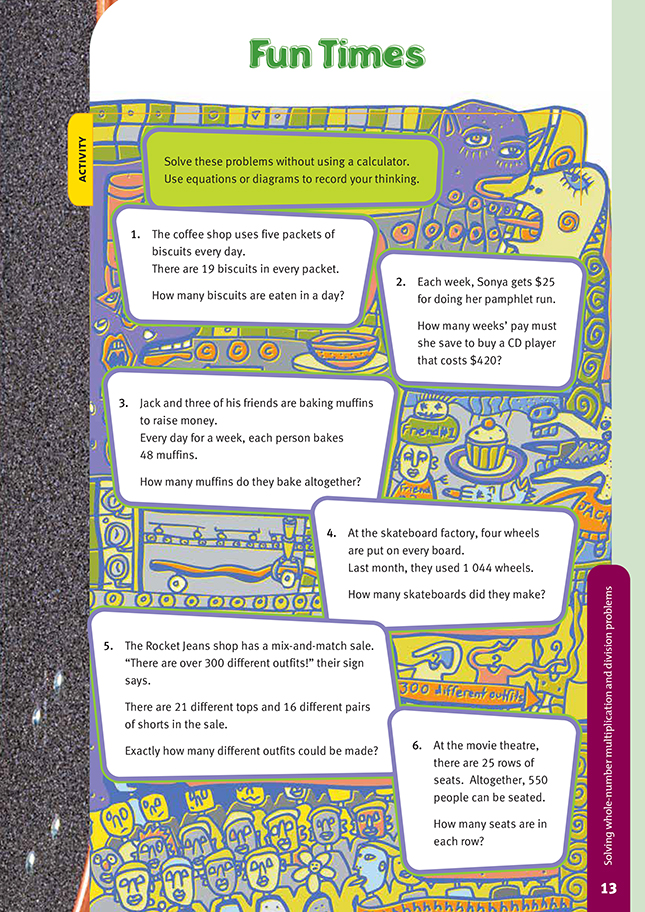This is a level 4 number link activity from the Figure It Out series. It relates to Stage 7 of the Number Framework.
A PDF of the student activity is included.
Click on the image to enlarge it. Click again to close. Download PDF (284KB)
use mental strategies to solve multiplication and division problems
FIO, Link, Number, Book Two, Fun Times, page 13
This activity is similar to that on page 12, but it uses multiplication and division contexts. As in the activity on page 12, the thinking strategies used to get to the answers are the most important part of the questions.
The students could again work in co-operative, problem-solving groups of four.
Question 1 is a conventional “sets of” context, so the likely equation will be 5 x 19 =. Emphasise to your students that their job as mathematicians is to find an easy and efficient way to handle the problem but that there is more than one way to do this. Thinking strategies that involve counting or addition, such as adding 5 nineteen times, may be easy, but they are not efficient. Strategies such as knowing that 5 x 20 is 100 and recognising that 5 x 19 is one 5 fewer, so the answer is 95, or that 10 times 19 is 190, so 5 times 19 is half of this, show that a student has developed more advanced thinking skills and will have more choices of methods to solve problems.
The equation for question 3 will have three factors, 4 x 7 x 48. Encourage the students to reorganise the factors in a way that they find easy. They may find that it is easier to multiply the 48 x 4 and then multiply by 7. If the equation were turned into prime factors, the students would get 7 x 3 x 2 x 2 x 2 x 2 x 2 x 2. This means that 21 (the 7 x 3) is doubled six times (42, 84, 168, 336, 672, and 1 344). The answer is 1 344. You may wish to share this idea with your students.
One of your most important duties as a teacher of mathematics is helping students to see the connections between what they already know and what they have to find out.
Answers to Activity
Answers and a possible method for each problem are:
1. 95 biscuits
5 x 20 = 100
so 5 x 19 = 100 – 5
= 95
2. 17 weeks
100 ÷ 25 = 4
so 400 ÷ 25 = 16
420 – 400 = 20 (1 more week’s pay)
16 + 1 = 17
3. 1 344 muffins
4 x 48 x 7:
4 x 50 = 200
so 4 x 48 = 200 – 8
= 192
200 x 7 = 1 400
so 192 x 7= 1 400 – (8 x 7)
= 1 400 – 56
= 1 344
4. 261 skateboards
x 4 = 1 044
25 x 4 = 100
so 250 x 4 = 1 000
11 x 4 = 44
so = 250 + 11
= 261
5. 336 outfits
20 x 16 = (20 x 10) + (20 x 6)
= 200 + 120
= 320
so 21 x 16 = 320 + 16
= 336
6. 22 seats
500 ÷ 25= 20
50 ÷ 25 = 2
so 550 ÷ 25 = 20 + 2
= 22
or
25 x = 550
25 x 4 = 100, so 25 x 20 = 500
25 x 2 = 50
20 + 2 = 22
